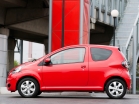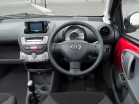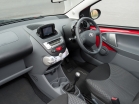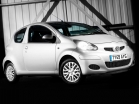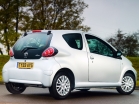Driver and passengers. General score 25 | 68%
Frontal blow (10.8 points)

Driver |

Passenger |
 | - | Excellent |
 | - | Good |
 | - | Satisfactorily |
 | - | Badly |
 | - | Very bad |
|
|
| Head |
| Contact of the driver's head with a pillow of safety | stable |
| Contact of the passenger head with a pillow of safety | stable |
| Breast |
| Passenger department | stable |
| Front rack displacement | 24mm |
| Shift of the steering wheel back | 39mm |
| Steering wheel offset | 45mm |
| Breast contact with the steering wheel | yes |
| Upper part of the legs, knees and hip area |
| Contact with solid elements of the front panel | Steering column with position adjustment and protective casing; egnition lock |
| Point loads on knees | Steering column with position adjustment, as well as a protective casing; egnition lock |
| Lower part of the leg and foot |
| Compression of the recess for the legs | no |
| The displacement of pedals back | brake pedal - 140mm |
| The displacement of the pedals up | clutch pedal - 12mm |
|
Side collision with a car (6.3 points), and with a pillar (6.5 points)
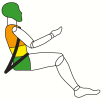
Automobile |

Pillar |
|
| Headbrush pillow | yes |
| Pillow for breasts | yes |
|
Back in the back (protection of the spine) (points)
|
|
| Description of the chair | Standard, manual adjustment in 4 positions |
| Type of the headrest | passive |
| Geometric assessment | 0 |
| Testing |
| - A strong blow | 1,4 |
| - Average blow | 0,9 |
| - A weak blow | 0,7 |
|
Children-passengers. General score 36 | 73%
| Child up to 18 months |
| Mark of the chair | ritax-R | Frontal blow |
| Roof group | 0+ | The movement of the head forward | protected |
| Location | face back | Acceleration of the head | maximum rating |
| Fastening | adult seat belts | Stress on the chest | weak |
| Side blow |
 | Protection assessment | 8,6 | Fixation of the head | protected |
| Marking assessment | 4 | Acceleration of the head | max rating |
| Assessment of mounting | 2 | |
| A child over 3 years old |
| Mark of the chair | ritax-R | Frontal blow |
| Roof group | I | The movement of the head forward | protected |
| Location | face forward | Acceleration of the head | maximum rating |
| Fastening | ISOFIX fastening with a safety cable | Stress on the chest | maximum rating |
| Side blow |
 | Protection assessment | 12 | Fixation of the head | protected |
| Marking assessment | 4 | Acceleration of the head | max rating |
| Assessment of mounting | 2 | |
| Assessment of the car | 3 | Prevention of the presence of airbag | Text and graphic icon are applied on both visors |
Pedestrians. General score 19 | 53% system act. Security General score 5 | 71%

 - Excellent - Excellent
|
 - Good - Good
|
 - Satisfactory - Satisfactory
|
|
|
| Speed \u200b\u200blimiter | The presence was not evaluated |
| Excurs stability system (ESC) | 3 |
| Alarm about unknown seat belts | Two: driver and front passenger |
| Head | 13,2 |
| Hip area | 0 |
| Legs | 6 |
|
Protection of adult passengers:
In the frontal collision, the Toyota Aygo reaction was the same as that of the Citroën C1 car tested in 2005, so the data was used in the implementation of this test. In the frontal impact, the passenger salon Toyota Aygo retained integrity. However, the driver’s chest department was injured in a collision with the steering wheel, so the model lost additional points. Sensors on the mannequin showed good protection of the knees and hips of the front riders. However, the inspection of the dashboard showed that some parts and elements represent the risk of injury, depending on the growth of the person and the position in which he was. The deformation in the area of \u200b\u200bthe legs was minimal, but the testers noted that the brake pedal was blocked and moved back, thus increasing the risk of injury to the driver and feet of the driver. Side airbags, which were only optionally available until 2013, became the standard on all models. The sensors showed that the seats and head restraints have a very low protection of the cervical spine in the event of a rear clash.
Safety of passenger children
Based on the indications in the frontal and lateral tests, Aygo scored the maximum number of balls for protecting a 3-year-old child, the mannequin sat in the children's chair, which was recorded by the ISOFIX mount, the use of which is currently not standard equipment, but which will become this in July 2013. The movement of the head forward and to the sides did not exceed the norm. In both tests, they received confirmations that parts of the interior do not damage the mannequin. A passenger airbag can be disabled to allow the use of children's seats back.
Pedestrian protection
The bumper scored the maximum number of points, providing good protection of the foot of pedestrians in all trials. However, the front edge of the hood did not score a single point.
Pedestrian protection
The electronic course of course stabilization (ESC) is currently an additional option, but will be standard equipment on all models in July 2013. The system meets the requirements of Euro NCAP. The signaling devices of the unhealthy seat belt in the driver’s chair are included in the standard package, and for the front passenger it will become a standard only in July 2013. There are no alarms for the rear riders, as well as the speed restriction device.
General information about the car
| Tested model |
Toyota Aygo 1.0 High Grade, model with left -hand drive |
| Type of body |
hatchback (5 doors) |
| Year of data publication |
2012 |
| Equipped mass, kg |
845 kg |
| The results are valid for VIN, starting with ... |
see comments |
Safety system equipment:
| Front seat belts |
There is |
| Front seat belts load limiters |
There is |
| Front Pillow of Safety of the driver |
There is |
| Passenger front pillow |
There is |
| Side airbags |
Standard since July 2013 |
| Side pillows for head safety pillows |
Standard since July 2013 |
| Driver's knees pillow |
Not |
| The system of dynamic stabilization |
Standard since July 2013 |
| Reminder of unsatted seat belts |
Standard for the driver, standard for the front passenger - since July 2013 |

